Ski report from Tarredalen, March '96
Also available translated to German.
If you want the background to these stories, see the introduction.
You can see more photos in the gallery.
March 11th. The forecast was for a stable high pressure, -5 to -10C,
and minimal wind. Perfect. I took the school bus two hours west from
Jokkmokk to Kvikkjokk, enjoying the sight of the reindeer and moose that
popped up from time to time, marvelling at how quiet and well behaved the
school children were, and being quietly amused by the rural post-delivery
system that involved the bus driver winding down his window, slowing down
marginally, and lobbing a bag into the snow somewhere near the appropriate
house. I rented a cabin (stuga in Swedish) at Turistservice, essentially a
summer resort, but it takes in a few skiers before the Swedish Tourist
Association (STF) fjaellstation opens later in March. It was nice enough,
but a little desolate and lonely on a dark winter's night, and I was a teeny
bit apprehensive about what I was about to do, viz. ski for two days in a row,
rest a day, and come back. It sounds pretty wimpy now, but it was scary then.
The only other visitor in the cabins was the bus driver, waiting to take
the children back to school at 6 the next morning.
There's a little shop there too, open an hour or two in the evening for
last-minute chocolate rations, and tinned food for my last heavy meal.
Most people ski here in April, when the days are much longer and the chance
for storms is less, but I had a job starting soon and so had to go early.
The advantage was that I always had plenty of space and peace in the cabins,
and I didn't have to worry about high temperatures and soft snow.
I woke early to nice enough weather, -10C and overcast, but where was the
snow ? Down on the lake all I saw was ice. It turns out that '96 was a record
year for snow in Sweden - a record high in the south and a record low in the
north. There was still a metre or so in the forests, but almost none on
exposed ground, and the lakes were blown clean. I skied down to the lake and
found that the ice wasn't even flat, currents and freeze-thaw cycles had
produced sharp jutting plates and knife edges. My skis had no steel edges,
just hickory reinforcement, so my legs splayed on the flat regions, and wildly
followed the rules of physics elsewhere. Progress was slow and painful.
My wrists hurt from sudden corrective stabs, my shoulders hurt from the extra
5kg in my pack, and my head hurt from trying to work out why I was here, and
how I could have ignored my friends' advice to stay at home. It seemed
impossible that I would ever get to Njunjesstugan, 16km away. After 1 1/2
hours of torture I reached the forest, 3km from Kvikkjokk. At this rate it was
another 6 hours to the cabin. Aggghhgg !
Luckily I had an ace up my sleeve - stubborness, something I never leave home
without. I also had chocolate and coffee, which I savoured on a tree stump
before continuing. A police patrol came by on a scooter, looking for a lone
skier who had been reported as being 'confused'. I didn't fit the rest of the
description, so they cruised on. It was nice to know that they were about.
Skiing in the forest was blissfully easy after the jagged lake, if a little
monotonous, and occasionally disquieting since Padjelantaleden is not winter
marked, and I had to trust that I was following the right scooter track until
I came to the telephone line that feeds a lone telephone that is used to
call for boat transport across the lake in the summer.
I reached the cabin in 4 hours, and forgot all about my pain and pessimism
on the lake. I talked to the warden, and he told me that it was an easy, flat
6km to the next cabin, so I decided it was best to carry on that day and make
the next day short. Flat it was, since it was another lake, and mercifully
intact. However, a side wind had got up, strong enough to blow me sideways if
I didn't keep at least one pole dug into the ice. I was terribly happy to see
Tarrekaisestugan, actually 2 cabins, plus wood shed and outhouse.
The warden's door had a sign saying that he'd gone fishing, but welcome.
I went up to the guest cabin to find two hunters already arrived by scooter,
and wondered how these huge armed killers would respond to sharing their
room with a city boy on skis.
Maybe this is what my friends were thinking of when they told me
I wouldn't survive the trip. They responded by offering me hot fruit soup
and a pair of furry slippers. The soup tasted best. It seems that they only
hunt animals (birds actually, grouse), and were extremely friendly and chatty.
When I asked if they knew what the weather would be like the next day, one
disappeared outside. Ah ha, I thought, a real hunter, he's going to sniff the
air to find out. He was gone about half an hour, and when he came back he told me that it
would be -5 to -10C, 2-3 m/s, clouding over by lunchtime. Wow, no wonder
he had to sniff the air so long. Except he had actually called his wife on his
mobile phone, and had had to climb several hundred metres to get a signal.
It was a good evening. I was still alive, and was already more than half way
to my destination. How could my friends be so pessimistic ?
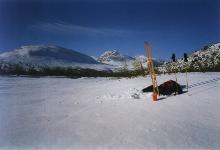 Normally I sleep badly and get up late. This night I slept deeply and woke early,
refreshed and happy. It was a beautiful, clear, still morning, and I chatted
to the wardens like the skiing veteran that I now was. It was hard to resist the
urge to gaze at sky and sagely predict clouds by lunchtime.
Normally I sleep badly and get up late. This night I slept deeply and woke early,
refreshed and happy. It was a beautiful, clear, still morning, and I chatted
to the wardens like the skiing veteran that I now was. It was hard to resist the
urge to gaze at sky and sagely predict clouds by lunchtime.
 It was
an easy 12km along the lake to Såmmarlappastugan, still icy, but
even 200m higher than Kvikkjokk there was noticeably more snow on the surface.
Starting to relax, I could now appreciate the beauty of the valley, with the
kilometre high walls to the east. The valley widens out at
Såmmarlappa, and the cabin
is in a clump of trees, so there is a danger of missing it in bad weather,
but not today. I was there by lunchtime,
happy and confident, and so decided
to take a day trip to Padjelanta national park 4km away, less than one hour.
The park starts just about where the valley reaches tree line, which was an
exciting new experience for me. As was returning to the cabin through the
forest.
It was
an easy 12km along the lake to Såmmarlappastugan, still icy, but
even 200m higher than Kvikkjokk there was noticeably more snow on the surface.
Starting to relax, I could now appreciate the beauty of the valley, with the
kilometre high walls to the east. The valley widens out at
Såmmarlappa, and the cabin
is in a clump of trees, so there is a danger of missing it in bad weather,
but not today. I was there by lunchtime,
happy and confident, and so decided
to take a day trip to Padjelanta national park 4km away, less than one hour.
The park starts just about where the valley reaches tree line, which was an
exciting new experience for me. As was returning to the cabin through the
forest.
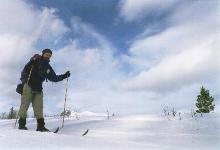 I'm not sure why the crust broke so much, because it held on the way
up, but for some reason, probably poor balance due to tiredness and hunger,
one ski kept breaking through and tumbling me upside down in the metre-deep
snow.
You'll remember from the introduction that I don't like that.
Each recovery took 5-10 minutes and made me more tired and quicker to lose my
balance again, and all the time it was getting darker.
My half-full pack might
have been lighter, but it was also less stable as I had no compression straps.
I knew that I would get back eventually, but what I didn't know was how quick
wardens are to call out rescue teams. Not very, I now know. That's no slight
on them, they just know that a lot of people come back late or find somewhere
safe to overnight. They also work on the principle that people should take
responsibility for themselves, a fine principle I think. Still, I was worried
about causing unnecessary worry. I got back just after dark.
I'm not sure why the crust broke so much, because it held on the way
up, but for some reason, probably poor balance due to tiredness and hunger,
one ski kept breaking through and tumbling me upside down in the metre-deep
snow.
You'll remember from the introduction that I don't like that.
Each recovery took 5-10 minutes and made me more tired and quicker to lose my
balance again, and all the time it was getting darker.
My half-full pack might
have been lighter, but it was also less stable as I had no compression straps.
I knew that I would get back eventually, but what I didn't know was how quick
wardens are to call out rescue teams. Not very, I now know. That's no slight
on them, they just know that a lot of people come back late or find somewhere
safe to overnight. They also work on the principle that people should take
responsibility for themselves, a fine principle I think. Still, I was worried
about causing unnecessary worry. I got back just after dark.
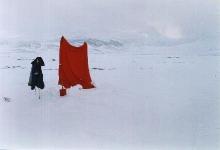 The warden was cool. He chooses Såmmarlappa because it's so infrequently
visited, and he can play his violin undisturbed for days at a time. But still
he is most welcoming to those of us who do find our way there.
Feeling I didn't need my planned rest day, the following morning I took a day
trip up to Fierrovagge, 6km skiing and 500m up, beyond tree line.
The warden was cool. He chooses Såmmarlappa because it's so infrequently
visited, and he can play his violin undisturbed for days at a time. But still
he is most welcoming to those of us who do find our way there.
Feeling I didn't need my planned rest day, the following morning I took a day
trip up to Fierrovagge, 6km skiing and 500m up, beyond tree line.
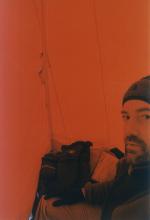 It was very icy and I was glad that I'd borrowed climbing skins, which I used
both up and down. Skins are great - sometimes essential, but sometimes just
good to compensate for undeveloped skiing and waxing skills.
A tiny storm
passed by at lunchtime, and I felt like Robert Scott having my lunch
in my windsack. Then I remembered that he didn't make it home. I decided to be
Walter Scott instead.
It was very icy and I was glad that I'd borrowed climbing skins, which I used
both up and down. Skins are great - sometimes essential, but sometimes just
good to compensate for undeveloped skiing and waxing skills.
A tiny storm
passed by at lunchtime, and I felt like Robert Scott having my lunch
in my windsack. Then I remembered that he didn't make it home. I decided to be
Walter Scott instead.
Safely back at the stuga I chatted some more to the warden, and he persuaded
me not to turn back yet, but to go on to Tarraluoppal, which was so much nicer
than anywhere I'd yet been, and just 13km on, just inside the boundary of
Sarek national park. But the next day I felt bad, something like a cold, and
sat around the stuga thinking what a disaster a cold would be at this point,
even though Såmmarlappa has food for sale and so I could in principle stay
there indefinitely. But it seems that I was just exhausted and depleted of
food, as my day of resting and eating revived me, and next morning I headed
north again.
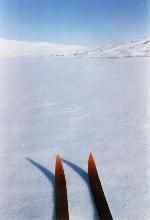 Private scooters are not allowed in the park, so there are few tracks,
but visibility was good and navigation was easy. It was however cloudy and
windy, so I tried to have a quick lunch and move on,
without setting up the windsack or putting on dry clothes. This was a big
mistake, as my sweat quickly cooled as I stopped moving, and when I set off
again I was cold for the first time on the trip. Horribly cold for 20 minutes
or so until I had burned enough food to warm my sweaty clothes again.
It seemed a long 4 hours
to the cabin, which was unmanned and sub-zero when I
arrived. Unusually for these cabins it was heated by bottled gas rather than
wood, and for a horrible few minutes it seemed like the gas was empty, until I
found the third stopcock that needed to be opened.
Private scooters are not allowed in the park, so there are few tracks,
but visibility was good and navigation was easy. It was however cloudy and
windy, so I tried to have a quick lunch and move on,
without setting up the windsack or putting on dry clothes. This was a big
mistake, as my sweat quickly cooled as I stopped moving, and when I set off
again I was cold for the first time on the trip. Horribly cold for 20 minutes
or so until I had burned enough food to warm my sweaty clothes again.
It seemed a long 4 hours
to the cabin, which was unmanned and sub-zero when I
arrived. Unusually for these cabins it was heated by bottled gas rather than
wood, and for a horrible few minutes it seemed like the gas was empty, until I
found the third stopcock that needed to be opened.
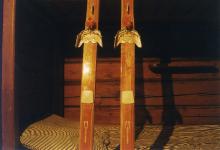 I dived into my sleeping
bag and slept deeply while the cabin warmed up. It was certainly a beautiful
place, but I was all alone 50km from the nearest road, with 3 days food
supplies. What if I went down with a cold now ? Pneumonia would be OK, as I
could use the emergency radio in the cabin to call for help, but one can
hardly call a helicopter for a cold. I wondered if I should practice faking
the symptoms of pneumonia.
My feelings oscillated between elation at having
come so far, through horror at how vulnerable I felt, to sheer pleasure at
being in such a beautiful, unspoiled place, which for the first time looked
like real mountains and not just steep forests. The cabin became comfortably
warm, and
the varnish on my skis glowed beautifully in the light of the oil
lamp. Eventually the cosiness of it all let me give in and unequivocally
enjoy the experience. I didn't want to go back. I even looked at the map to
see how far it was to Ritsem on the next road north. A long way was the answer
(100km), over exposed peaks, not a good idea. But maybe I could stay here
another day if it were sunny and still. But if it were sunny and still I
should really use it to ski - what if a 3-day storm followed that one sunny
day ? Best to head back I decided, and settled into a deep happy sleep from
which I awoke at 6 o'clock to find the other cabins gone.
I dived into my sleeping
bag and slept deeply while the cabin warmed up. It was certainly a beautiful
place, but I was all alone 50km from the nearest road, with 3 days food
supplies. What if I went down with a cold now ? Pneumonia would be OK, as I
could use the emergency radio in the cabin to call for help, but one can
hardly call a helicopter for a cold. I wondered if I should practice faking
the symptoms of pneumonia.
My feelings oscillated between elation at having
come so far, through horror at how vulnerable I felt, to sheer pleasure at
being in such a beautiful, unspoiled place, which for the first time looked
like real mountains and not just steep forests. The cabin became comfortably
warm, and
the varnish on my skis glowed beautifully in the light of the oil
lamp. Eventually the cosiness of it all let me give in and unequivocally
enjoy the experience. I didn't want to go back. I even looked at the map to
see how far it was to Ritsem on the next road north. A long way was the answer
(100km), over exposed peaks, not a good idea. But maybe I could stay here
another day if it were sunny and still. But if it were sunny and still I
should really use it to ski - what if a 3-day storm followed that one sunny
day ? Best to head back I decided, and settled into a deep happy sleep from
which I awoke at 6 o'clock to find the other cabins gone.
Fog. 30m visibility fog. Not good, I thought, cold and disorienting.
I said earlier that it was hard to get lost in Tarredalen. However, just
missing a compass bearing by a few degrees across the Tarraluoppal basin would
put me on the wrong side of the river canyon, in the deep soft snow that gave
me so much trouble before. I wouldn't be lost so much as stuck. I resigned
myself to a day in the cabin writing novels and signing them Walter Scott.
But by 9 o'clock the fog had started to burn off from the high ground, and I hoped
that it would work its way down the valley faster than I skied, which it did.
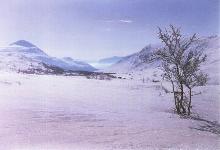 Clear and sunny with a tiny following wind gave
perfect skiing conditions
down to tree line again. A group of Sami scootered by, having special
permission to drive in the park in connection with reindeer farming.
Back at Såmarlappa I met my first fellow tourists, a pair of Germans in the
middle of a 100km snowshoe tour.
Clear and sunny with a tiny following wind gave
perfect skiing conditions
down to tree line again. A group of Sami scootered by, having special
permission to drive in the park in connection with reindeer farming.
Back at Såmarlappa I met my first fellow tourists, a pair of Germans in the
middle of a 100km snowshoe tour.
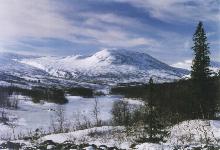 I was starting to overrun my timetable, and although I knew my friends would
know that such things happen in the mountains, I still wanted to let them know
I was OK. That is considered valid use of the emergency radio, which is
actually called a 'help telephone' to reflect this, and the police are happy
to pass on messages that might prevent a call-out. But I had left my address
book behind thinking I would have no use for it up there. Still, I knew that if
anyone really wanted to check up on me, a few calls to the cabins would trace
my movements and reassure people that I was OK.
Another beautiful day and
sheer joy whizzing 19km down to Njunjes in 4 hours, with lunch at Tarrekaise
with a group from a home for the mentally handicapped who were on a day trip
by scooter caravan. Then I met my first fellow skiers, in the form of 3
Germans heading north. They nodded Germanically at me as they passed.
I was starting to overrun my timetable, and although I knew my friends would
know that such things happen in the mountains, I still wanted to let them know
I was OK. That is considered valid use of the emergency radio, which is
actually called a 'help telephone' to reflect this, and the police are happy
to pass on messages that might prevent a call-out. But I had left my address
book behind thinking I would have no use for it up there. Still, I knew that if
anyone really wanted to check up on me, a few calls to the cabins would trace
my movements and reassure people that I was OK.
Another beautiful day and
sheer joy whizzing 19km down to Njunjes in 4 hours, with lunch at Tarrekaise
with a group from a home for the mentally handicapped who were on a day trip
by scooter caravan. Then I met my first fellow skiers, in the form of 3
Germans heading north. They nodded Germanically at me as they passed.
Just one day left, and I was beginning to feel that I'd been underambitious
with this trip, though I also knew that if I'd been less lucky with the
weather I would probably have considered it overambitious. It was probably a
well-judged choice really. But I'd always been down in the valley, and I
wanted to be on a peak, so after dumping most of my stuff in the stuga, I
ascended 400m to Råkas in less than 1 hour, irrationally proud of not using
my skins. It was cold, somewhere around -15C, and windy, maybe 5 m/s, and I
was working hard up the hill, sweating profusely. It was then that I suffered
the dreaded Gore-Tex failure. As I overwhelmed the breathing ability of the
material, my sweat started to condense and freeze on the inside of my jacket,
blocking its breathing capacity further, and causing a rapid build-up of ice
in my clothes. The solution seemed to be to shake out the ice, put on a dry
fleece jacket and let the wind dry out the shirt under that at the expense of
huge numbers of calories from my body.
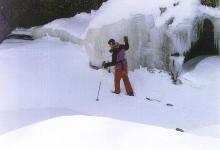 The view was spectacular, north up the valley and Tarrekaise itself,
east all the way to Kvikkjokk, and west over Staika. Aware that I was always
within sight of the cabin, I recklessly slalomed back down, breaking a pole in
a fall on the way. The worst thing about this was that after taping it up I
kept losing the white basket, which was incredibly difficult to find again in
30cm of snow. I saw ski tips in the sky that evening - cirrus clouds, the sign
of a warm front and snow. It looked like my timing was good. The next morning
was dull and grey, and the adrenaline that had sustained me thus far started
to ebb. I was well satisfied with all the exciting skiing I had done, and now
wearily trudged through the monotonous forest again, wanting only to get to
Kvikkjokk and digest my experiences. Until I met a Dutchman who had just
completed 3 weeks camping in Sarek, alone in a summer tent, and with a bottle
insulated with a sock for a thermos. Winter campers are crazy, this one doubly
so. But friendly, and we joined up for the last leg of our trip. He also
thought the forest was boring, and that the river would be much more fun,
especially with the 3 metre drops, open water concealed by
soft snow cornices,
and the like. Crazy, but technically competent and a good antidote to my
weariness. My adrenaline came back the first time we needed ropes to get our
kit down a waterfall. And suddenly we were in Kvikkjokk, where my adrenaline
once again left me, and I reflected on my trip.
The view was spectacular, north up the valley and Tarrekaise itself,
east all the way to Kvikkjokk, and west over Staika. Aware that I was always
within sight of the cabin, I recklessly slalomed back down, breaking a pole in
a fall on the way. The worst thing about this was that after taping it up I
kept losing the white basket, which was incredibly difficult to find again in
30cm of snow. I saw ski tips in the sky that evening - cirrus clouds, the sign
of a warm front and snow. It looked like my timing was good. The next morning
was dull and grey, and the adrenaline that had sustained me thus far started
to ebb. I was well satisfied with all the exciting skiing I had done, and now
wearily trudged through the monotonous forest again, wanting only to get to
Kvikkjokk and digest my experiences. Until I met a Dutchman who had just
completed 3 weeks camping in Sarek, alone in a summer tent, and with a bottle
insulated with a sock for a thermos. Winter campers are crazy, this one doubly
so. But friendly, and we joined up for the last leg of our trip. He also
thought the forest was boring, and that the river would be much more fun,
especially with the 3 metre drops, open water concealed by
soft snow cornices,
and the like. Crazy, but technically competent and a good antidote to my
weariness. My adrenaline came back the first time we needed ropes to get our
kit down a waterfall. And suddenly we were in Kvikkjokk, where my adrenaline
once again left me, and I reflected on my trip.
It was unquestionably a success; I was still alive, possibly more so than
when I started; the ambition level was high enough to be a continuous
challenge without overwhelming me; and the weather had been generally very
good, with just enough bad weather to show me what it could have been like all
the time. There was no doubt that I would be ski touring again.
What would I change next time ? Possibly add some indoor shoes for the cabins,
definitely get steel-edged skis, though I was told that in a normal year I
would have been in soft snow and not needed them. Maybe. Otherwise I was very
happy with my equipment and decisions.
Ski touring is great. If you're hesitating, stop it, and think about Tarredalen.
© Mark Harris 1996
Postscript 2004 :
A modified version of this story was published in the Danish magazine
Adventure World
and in the introduction to that issue the editor encouraged readers to go
to the magazine's website and discuss the question
"Is Mark Harris a true adventurer or a reckless fool". Sadly their website was
down for several weeks with technical problems, so I still don't know which
one I am. If you know, please feel free to keep it to yourself.
(On to Kungsleden)
(Back to ski report index)
(MRH homepage)

 Normally I sleep badly and get up late. This night I slept deeply and woke early,
refreshed and happy. It was a beautiful, clear, still morning, and I chatted
to the wardens like the skiing veteran that I now was. It was hard to resist the
urge to gaze at sky and sagely predict clouds by lunchtime.
Normally I sleep badly and get up late. This night I slept deeply and woke early,
refreshed and happy. It was a beautiful, clear, still morning, and I chatted
to the wardens like the skiing veteran that I now was. It was hard to resist the
urge to gaze at sky and sagely predict clouds by lunchtime.








